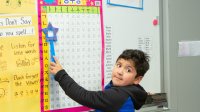Highlighting World Languages in Elementary School
The elementary grades are a great time for students to learn about world languages. Simple strategies include having signs in multiple languages.
Your content has been saved!
Go to My Saved Content.Only 20 percent of elementary schools in the United States offer world language education, according to a 2017 report. This period in life, however, is very effective for learning languages. If we want to prepare our children to be global learners, we must make world languages an integral part of their school’s culture.
We can achieve this in various ways, whether our school is interested in offering one or more world languages. Here are some ideas.
Putting world languages in the spotlight
Signage throughout the school and posters in multiple languages: The quickest and most lasting way to bring world languages into your school is to post signs in several languages throughout the building.
Display posters in multiple languages created for educational purpose—for example, parts of the body labeled in at least two languages for the nurse’s office. As you walk around the school with students, encourage them to look at the signs and model saying the words aloud. If you need help with pronunciation and have access to a smartphone, use Google Translate (scan the text, choose “English to English” mode regardless of the language, select “camera,” zoom in on the word and take a photo, then select “listen” to hear a faintly authentic pronunciation of the text in the target language that you’ve scanned).
Word of the week and morning announcements: Email a new word or phrase of the week, and include a link to Google Translate for pronunciation. The word can be something easy to integrate in classroom instruction, especially physical education class, like up, down, walk, jump. Invite teachers to post these on a word wall and integrate them in their morning meetings.
Invite students to speak in a language other than English for the morning announcements. Multilingual students can translate some of the notices so they’re broadcast bilingually, or a student can read a poem or share an expression in another language along with the English translation.
Reading partners, guest presenters, and library read-alouds: Collaborate with middle and high school teachers to invite student volunteers to be reading partners with children in the elementary school. These can include students who need community service hours, those who are studying world languages, or English language learners who want to share their native language and culture. They can read bilingual books together with the children or simply read a bilingual book aloud to a class.
Invite multilingual students, staff, or guardians to be a guest presenter or do a show-and-tell of objects from their home culture and integrate their home language as they share the objects. They can also introduce the written language and have students practice writing.
Invite multilingual students to read alongside the librarian. They can read a bilingual book or bring an English text home to translate with the help of the parent or guardian so that they can later present it together with the librarian in class.
Bilingual videos for staff professional development and PTA workshops: Collaborate with the high school video production teacher to have students make videos to introduce frequently used vocabulary and phrases in another language for cafeteria workers, nurses, custodial staff, administrative assistants, and others in the school building. Encourage them to use some of the language when communicating with students. This can be especially useful when interacting with English learners.
Invite multilingual PTA members to volunteer to give in-class or after-school workshops to introduce their native language. They can use worksheets with a list of some basic vocabulary words that children can copy to practice writing.
Everyday communication and school publications: Start the school year by using some words in another language and make it the norm. You don’t need to be fluent in another language to do this. Type a bilingual list of the words and phrases that you use most frequently, check them for accuracy with a native speaker if possible, and post them in your classroom or office to reference and use with students.
Include a “World Language” section in school publications. Highlight the efforts that the school is making to promote world language education, and include images of student work and photos of their learning environments.
Projects and play-based after-school and summer enrichment programs: If the school district approves extra opportunities for language education, offer short-term workshops to introduce world languages. Teaching these doesn’t require fluency but does require a basic understanding of language acquisition. Popular children’s games like Red Rover; What Time Is It, Mr. Fox?; and Red Light, Green Light in other languages can work in physical education class.
Provide a bilingual list of words related to the subject that students are studying, and have them integrate the language into their project using this list. This can be as simple as writing the title of their project or labeling their drawings bilingually.
Early language potentials
Exposure to second language learning at an early age opens up a host of possibilities for students, including increased job opportunities, higher lifelong incomes, and greater likelihood of getting scholarships or grants after high school for travel and further studies.
World languages should be part of the culture of every elementary school in the United States. Even with limited funding, a school can reflect a rich global awareness for the benefit of all students.
